BSBWHS501 Assessment: WHS Legislations and Risk Management Report
VerifiedAdded on 2023/01/19
|16
|2751
|65
Report
AI Summary
This report, prepared by a student, addresses the requirements of BSBWHS501, focusing on Workplace Health and Safety (WHS) legislations and risk management, particularly within the context of Queensland. The report begins by outlining fundamental WHS legislations applicable to various workplaces, including accounting offices and call centers, detailing specific regulations and codes of practice. It emphasizes the importance of maintaining a safe and healthy environment, providing essential amenities like fire extinguishers and medical kits, and addressing the unique needs of employees, such as those working long hours on computers or overnight in call centers. The report then delves into the process of collecting and analyzing WHS information through records and reports, as mandated by the Queensland government. It also covers incident reporting procedures, including the role of WHSQ and WorkCover Queensland, and highlights the detailed legislations for commercial building sites, emphasizing protective measures and medical aid. Furthermore, the report outlines a seven-step risk management process, including objectives, planning, identification, evaluation, and management. It presents the hierarchy of risk control and provides examples where consultation with a WHS expert is required. The report then transitions to a case study involving a refurbishment project, analyzing relevant OHS and WHS legislations, comparing company policies to state regulations, and identifying personnel with specific WHS responsibilities. It culminates in a detailed hazard management plan, including identified hazards like fire, electrical, medical, suffocation, and noise, along with proposed actions and timelines, equipment requirements, and addresses issues during the project.
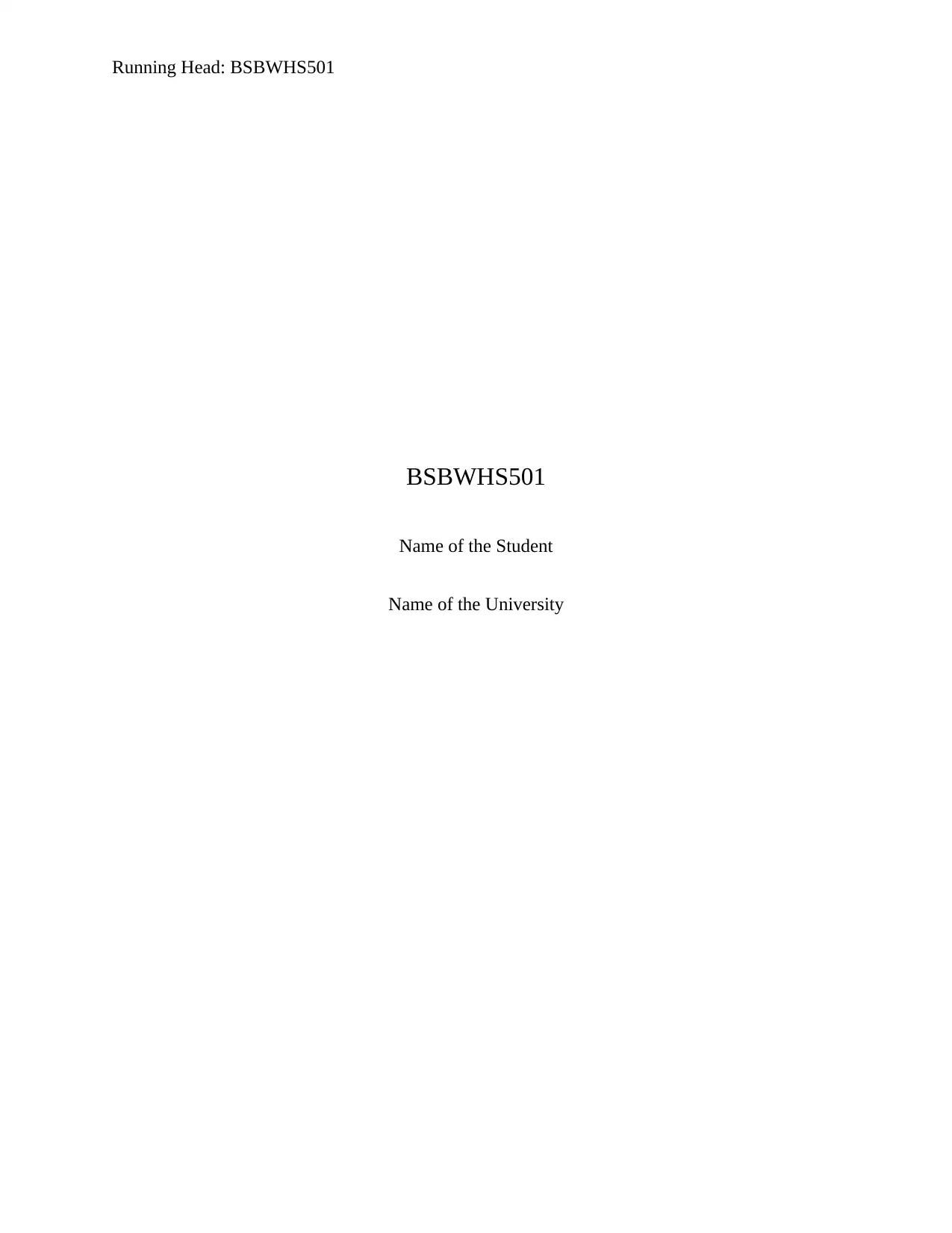
Running Head: BSBWHS501
BSBWHS501
Name of the Student
Name of the University
BSBWHS501
Name of the Student
Name of the University
Paraphrase This Document
Need a fresh take? Get an instant paraphrase of this document with our AI Paraphraser
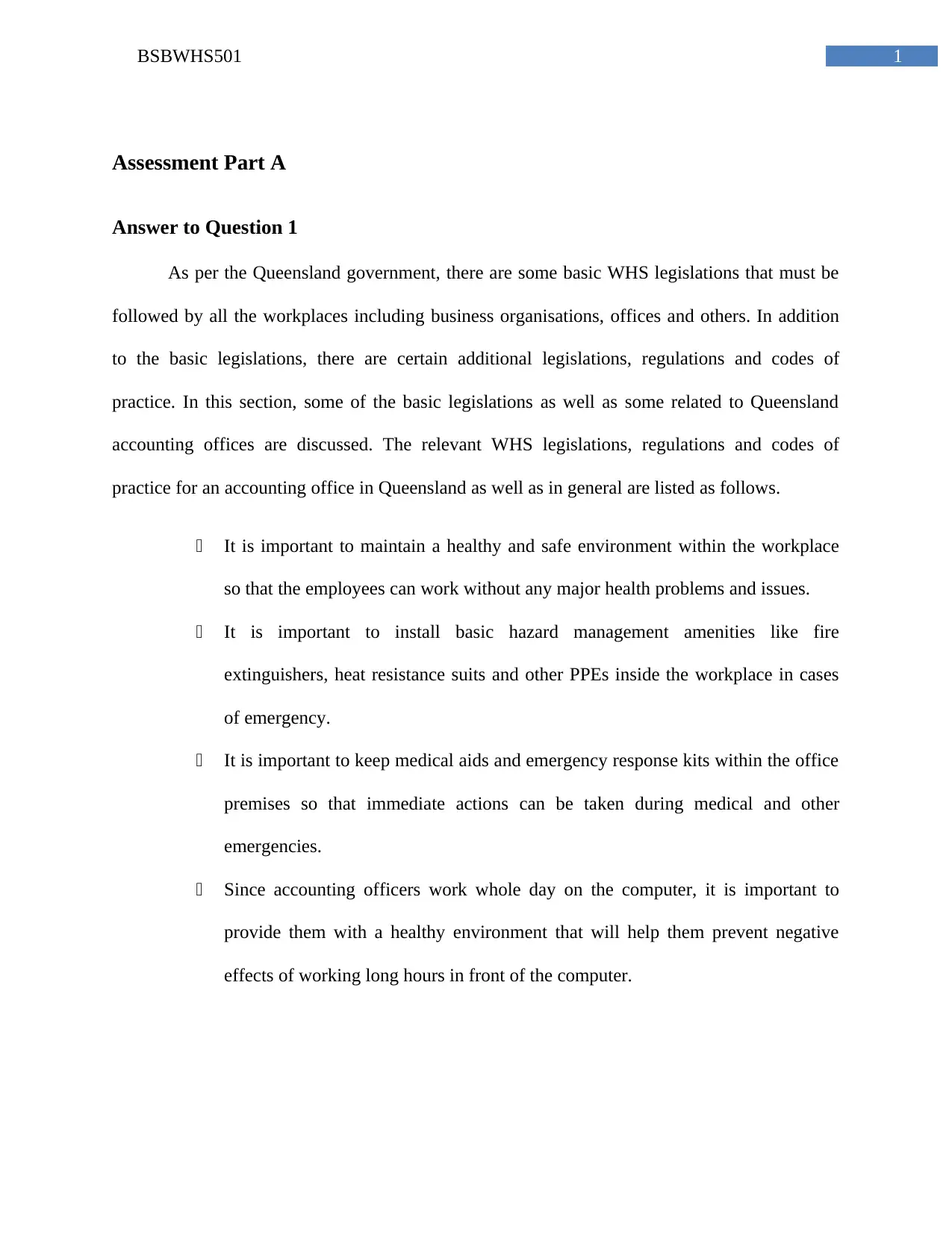
1BSBWHS501
Assessment Part A
Answer to Question 1
As per the Queensland government, there are some basic WHS legislations that must be
followed by all the workplaces including business organisations, offices and others. In addition
to the basic legislations, there are certain additional legislations, regulations and codes of
practice. In this section, some of the basic legislations as well as some related to Queensland
accounting offices are discussed. The relevant WHS legislations, regulations and codes of
practice for an accounting office in Queensland as well as in general are listed as follows.
It is important to maintain a healthy and safe environment within the workplace
so that the employees can work without any major health problems and issues.
It is important to install basic hazard management amenities like fire
extinguishers, heat resistance suits and other PPEs inside the workplace in cases
of emergency.
It is important to keep medical aids and emergency response kits within the office
premises so that immediate actions can be taken during medical and other
emergencies.
Since accounting officers work whole day on the computer, it is important to
provide them with a healthy environment that will help them prevent negative
effects of working long hours in front of the computer.
Assessment Part A
Answer to Question 1
As per the Queensland government, there are some basic WHS legislations that must be
followed by all the workplaces including business organisations, offices and others. In addition
to the basic legislations, there are certain additional legislations, regulations and codes of
practice. In this section, some of the basic legislations as well as some related to Queensland
accounting offices are discussed. The relevant WHS legislations, regulations and codes of
practice for an accounting office in Queensland as well as in general are listed as follows.
It is important to maintain a healthy and safe environment within the workplace
so that the employees can work without any major health problems and issues.
It is important to install basic hazard management amenities like fire
extinguishers, heat resistance suits and other PPEs inside the workplace in cases
of emergency.
It is important to keep medical aids and emergency response kits within the office
premises so that immediate actions can be taken during medical and other
emergencies.
Since accounting officers work whole day on the computer, it is important to
provide them with a healthy environment that will help them prevent negative
effects of working long hours in front of the computer.
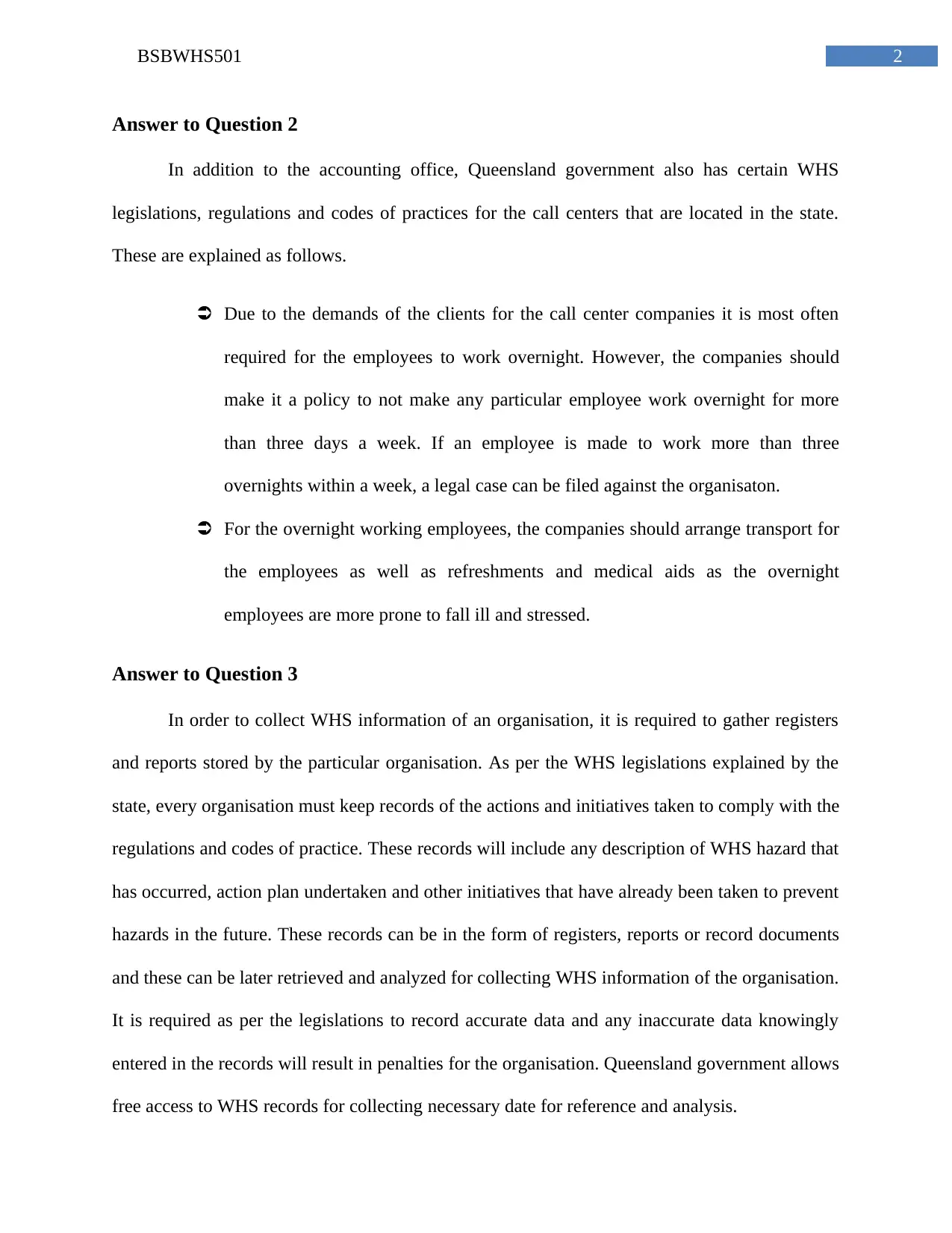
2BSBWHS501
Answer to Question 2
In addition to the accounting office, Queensland government also has certain WHS
legislations, regulations and codes of practices for the call centers that are located in the state.
These are explained as follows.
Due to the demands of the clients for the call center companies it is most often
required for the employees to work overnight. However, the companies should
make it a policy to not make any particular employee work overnight for more
than three days a week. If an employee is made to work more than three
overnights within a week, a legal case can be filed against the organisaton.
For the overnight working employees, the companies should arrange transport for
the employees as well as refreshments and medical aids as the overnight
employees are more prone to fall ill and stressed.
Answer to Question 3
In order to collect WHS information of an organisation, it is required to gather registers
and reports stored by the particular organisation. As per the WHS legislations explained by the
state, every organisation must keep records of the actions and initiatives taken to comply with the
regulations and codes of practice. These records will include any description of WHS hazard that
has occurred, action plan undertaken and other initiatives that have already been taken to prevent
hazards in the future. These records can be in the form of registers, reports or record documents
and these can be later retrieved and analyzed for collecting WHS information of the organisation.
It is required as per the legislations to record accurate data and any inaccurate data knowingly
entered in the records will result in penalties for the organisation. Queensland government allows
free access to WHS records for collecting necessary date for reference and analysis.
Answer to Question 2
In addition to the accounting office, Queensland government also has certain WHS
legislations, regulations and codes of practices for the call centers that are located in the state.
These are explained as follows.
Due to the demands of the clients for the call center companies it is most often
required for the employees to work overnight. However, the companies should
make it a policy to not make any particular employee work overnight for more
than three days a week. If an employee is made to work more than three
overnights within a week, a legal case can be filed against the organisaton.
For the overnight working employees, the companies should arrange transport for
the employees as well as refreshments and medical aids as the overnight
employees are more prone to fall ill and stressed.
Answer to Question 3
In order to collect WHS information of an organisation, it is required to gather registers
and reports stored by the particular organisation. As per the WHS legislations explained by the
state, every organisation must keep records of the actions and initiatives taken to comply with the
regulations and codes of practice. These records will include any description of WHS hazard that
has occurred, action plan undertaken and other initiatives that have already been taken to prevent
hazards in the future. These records can be in the form of registers, reports or record documents
and these can be later retrieved and analyzed for collecting WHS information of the organisation.
It is required as per the legislations to record accurate data and any inaccurate data knowingly
entered in the records will result in penalties for the organisation. Queensland government allows
free access to WHS records for collecting necessary date for reference and analysis.
⊘ This is a preview!⊘
Do you want full access?
Subscribe today to unlock all pages.

Trusted by 1+ million students worldwide
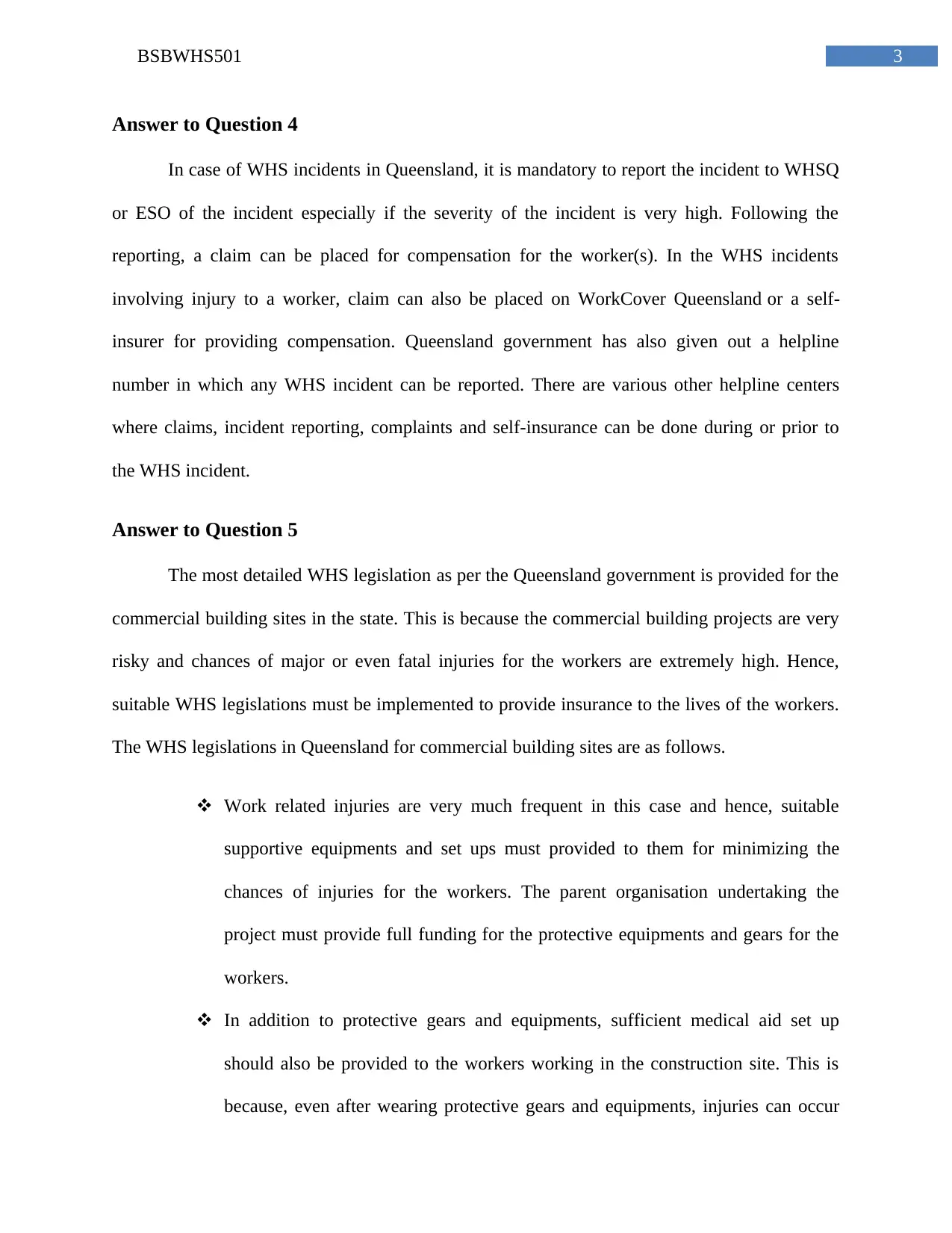
3BSBWHS501
Answer to Question 4
In case of WHS incidents in Queensland, it is mandatory to report the incident to WHSQ
or ESO of the incident especially if the severity of the incident is very high. Following the
reporting, a claim can be placed for compensation for the worker(s). In the WHS incidents
involving injury to a worker, claim can also be placed on WorkCover Queensland or a self-
insurer for providing compensation. Queensland government has also given out a helpline
number in which any WHS incident can be reported. There are various other helpline centers
where claims, incident reporting, complaints and self-insurance can be done during or prior to
the WHS incident.
Answer to Question 5
The most detailed WHS legislation as per the Queensland government is provided for the
commercial building sites in the state. This is because the commercial building projects are very
risky and chances of major or even fatal injuries for the workers are extremely high. Hence,
suitable WHS legislations must be implemented to provide insurance to the lives of the workers.
The WHS legislations in Queensland for commercial building sites are as follows.
Work related injuries are very much frequent in this case and hence, suitable
supportive equipments and set ups must provided to them for minimizing the
chances of injuries for the workers. The parent organisation undertaking the
project must provide full funding for the protective equipments and gears for the
workers.
In addition to protective gears and equipments, sufficient medical aid set up
should also be provided to the workers working in the construction site. This is
because, even after wearing protective gears and equipments, injuries can occur
Answer to Question 4
In case of WHS incidents in Queensland, it is mandatory to report the incident to WHSQ
or ESO of the incident especially if the severity of the incident is very high. Following the
reporting, a claim can be placed for compensation for the worker(s). In the WHS incidents
involving injury to a worker, claim can also be placed on WorkCover Queensland or a self-
insurer for providing compensation. Queensland government has also given out a helpline
number in which any WHS incident can be reported. There are various other helpline centers
where claims, incident reporting, complaints and self-insurance can be done during or prior to
the WHS incident.
Answer to Question 5
The most detailed WHS legislation as per the Queensland government is provided for the
commercial building sites in the state. This is because the commercial building projects are very
risky and chances of major or even fatal injuries for the workers are extremely high. Hence,
suitable WHS legislations must be implemented to provide insurance to the lives of the workers.
The WHS legislations in Queensland for commercial building sites are as follows.
Work related injuries are very much frequent in this case and hence, suitable
supportive equipments and set ups must provided to them for minimizing the
chances of injuries for the workers. The parent organisation undertaking the
project must provide full funding for the protective equipments and gears for the
workers.
In addition to protective gears and equipments, sufficient medical aid set up
should also be provided to the workers working in the construction site. This is
because, even after wearing protective gears and equipments, injuries can occur
Paraphrase This Document
Need a fresh take? Get an instant paraphrase of this document with our AI Paraphraser

4BSBWHS501
due to falling from height, fire, high voltage shock and others. In case these
incidents happen resulting in injury to the workers, immediate medical aid must
be provided before taking the worker to the hospital.
In addition to these guidelines, the workers also need to follow certain codes of
practice regarding their work, especially in the high risk projects. These codes of
practice are essentially designed to ensure safety of the workers and provided
them with a suitable environment suited for their work.
Answer to Question 6
In order to provide safe and sound environment for employees in the organisation as well
as increasing organisational readiness to hazards and risk events that may hamper the health and
safety of the employees, it is important to identify the hazards first. After the hazards are
identified, suitable action plans are to be developed to minimize the chances of occurrence of the
hazards. In order to identify the possible hazards, it is first required to understand the nature of
workplace of the organisation and the possible sources of hazards that may be present in the
workplace. Accordingly, the possible hazards are identified and appropriate plan is developed to
get rid of the hazards.
Answer to Question 7
The seven step risk management process that can be used for mitigating risks in the work
place is as follows.
Step 1 – Outlining Objectives: To specify the objectives for managing the risks that may
exist within the workplace
due to falling from height, fire, high voltage shock and others. In case these
incidents happen resulting in injury to the workers, immediate medical aid must
be provided before taking the worker to the hospital.
In addition to these guidelines, the workers also need to follow certain codes of
practice regarding their work, especially in the high risk projects. These codes of
practice are essentially designed to ensure safety of the workers and provided
them with a suitable environment suited for their work.
Answer to Question 6
In order to provide safe and sound environment for employees in the organisation as well
as increasing organisational readiness to hazards and risk events that may hamper the health and
safety of the employees, it is important to identify the hazards first. After the hazards are
identified, suitable action plans are to be developed to minimize the chances of occurrence of the
hazards. In order to identify the possible hazards, it is first required to understand the nature of
workplace of the organisation and the possible sources of hazards that may be present in the
workplace. Accordingly, the possible hazards are identified and appropriate plan is developed to
get rid of the hazards.
Answer to Question 7
The seven step risk management process that can be used for mitigating risks in the work
place is as follows.
Step 1 – Outlining Objectives: To specify the objectives for managing the risks that may
exist within the workplace

5BSBWHS501
Step 2 – Risk Management Plan: To develop a risk management plan that will be
followed through the process
Step 3 – Identification: To identify the risks associated with the workplace
Step 4 – Evaluation: To evaluate the impact of the risks on the WHS of the employees
Step 5 – Planning: To develop appropriate mitigation strategy for the identified risks
Step 6 – Management: To implement the mitigation strategies and manage the risks
accordingly
Step 7 – Feedback: To determine whether the mitigation strategies have been effective or
not through feedback process
Answer to Question 8
The hierarchy of risk control is shown in the following diagram.
Step 2 – Risk Management Plan: To develop a risk management plan that will be
followed through the process
Step 3 – Identification: To identify the risks associated with the workplace
Step 4 – Evaluation: To evaluate the impact of the risks on the WHS of the employees
Step 5 – Planning: To develop appropriate mitigation strategy for the identified risks
Step 6 – Management: To implement the mitigation strategies and manage the risks
accordingly
Step 7 – Feedback: To determine whether the mitigation strategies have been effective or
not through feedback process
Answer to Question 8
The hierarchy of risk control is shown in the following diagram.
⊘ This is a preview!⊘
Do you want full access?
Subscribe today to unlock all pages.

Trusted by 1+ million students worldwide
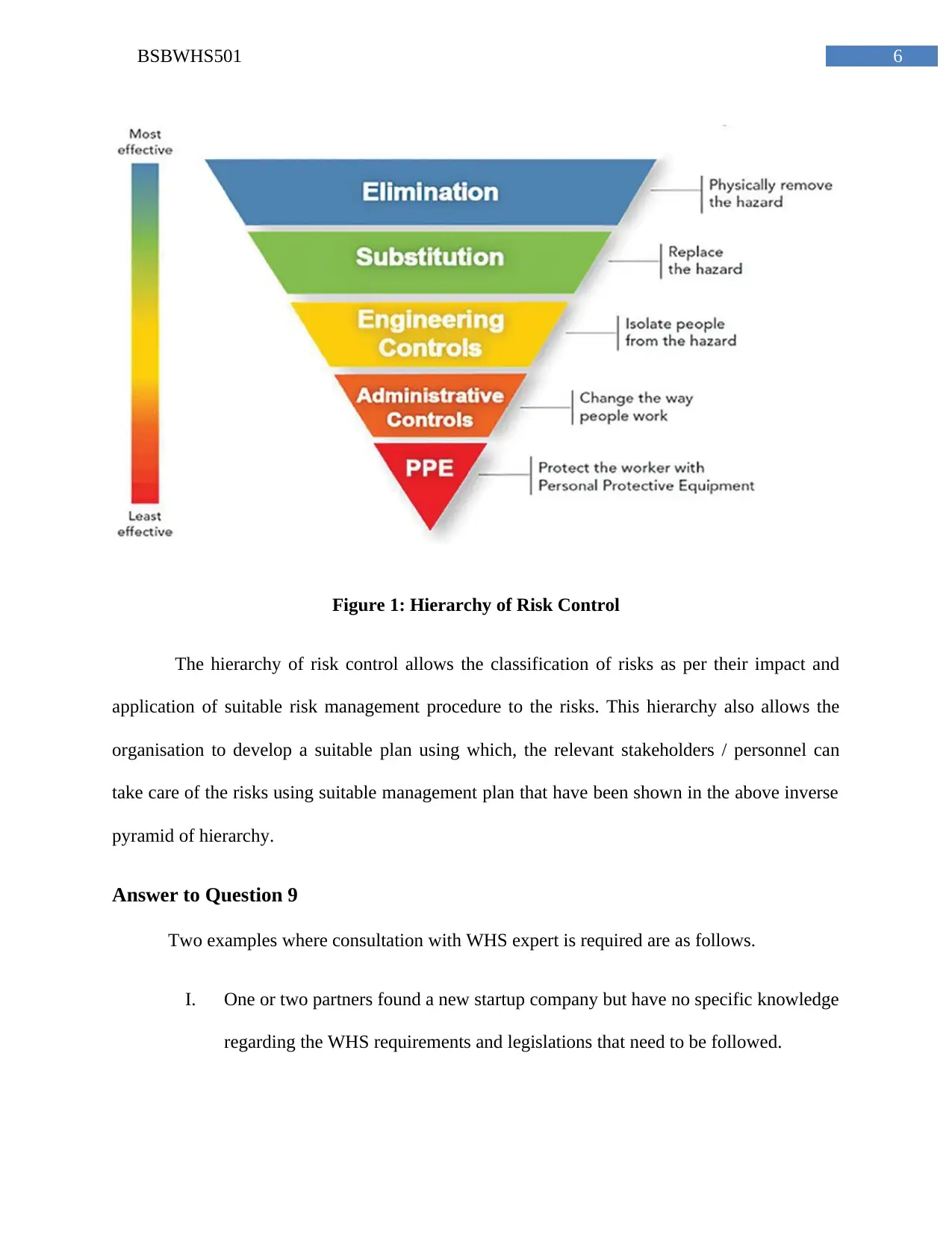
6BSBWHS501
Figure 1: Hierarchy of Risk Control
The hierarchy of risk control allows the classification of risks as per their impact and
application of suitable risk management procedure to the risks. This hierarchy also allows the
organisation to develop a suitable plan using which, the relevant stakeholders / personnel can
take care of the risks using suitable management plan that have been shown in the above inverse
pyramid of hierarchy.
Answer to Question 9
Two examples where consultation with WHS expert is required are as follows.
I. One or two partners found a new startup company but have no specific knowledge
regarding the WHS requirements and legislations that need to be followed.
Figure 1: Hierarchy of Risk Control
The hierarchy of risk control allows the classification of risks as per their impact and
application of suitable risk management procedure to the risks. This hierarchy also allows the
organisation to develop a suitable plan using which, the relevant stakeholders / personnel can
take care of the risks using suitable management plan that have been shown in the above inverse
pyramid of hierarchy.
Answer to Question 9
Two examples where consultation with WHS expert is required are as follows.
I. One or two partners found a new startup company but have no specific knowledge
regarding the WHS requirements and legislations that need to be followed.
Paraphrase This Document
Need a fresh take? Get an instant paraphrase of this document with our AI Paraphraser

7BSBWHS501
II. A company is venturing into a different domain of work and needs to identify the
WHS requirements for the new domain of business.
II. A company is venturing into a different domain of work and needs to identify the
WHS requirements for the new domain of business.

8BSBWHS501
Assessment Part B
Task One
The key OHS and WHS legislation that will affect the refurbishment project in the case
study are explained as follows.
I. The WHS legislation in Queensland demands safe environment for field workers
with appropriate technical and equipment support throughout the entire course of
work. This is applicable for the refurbishment project that is discussed in the case
study.
II. WHS and OHS legislations in Queensland demands suitable action plan for
protecting the health of the field workers from various hazards like fire, electricity
and other accidents.
III. Finally, the WHS states that the workers must be compensated equivalent to the
amount of work to be done by them and the extent of risk that they face during the
project.
The BizOps WHS policies and procedures are compared against the state policies in the
following table.
State Legislation Company Policy Need for Modifications
Safe Environment Company ensures safe
environment is available for the
workers
Company policy complies with
state legislation
Action Plan against Hazard Company does not provide any As per state legislation, it is
Assessment Part B
Task One
The key OHS and WHS legislation that will affect the refurbishment project in the case
study are explained as follows.
I. The WHS legislation in Queensland demands safe environment for field workers
with appropriate technical and equipment support throughout the entire course of
work. This is applicable for the refurbishment project that is discussed in the case
study.
II. WHS and OHS legislations in Queensland demands suitable action plan for
protecting the health of the field workers from various hazards like fire, electricity
and other accidents.
III. Finally, the WHS states that the workers must be compensated equivalent to the
amount of work to be done by them and the extent of risk that they face during the
project.
The BizOps WHS policies and procedures are compared against the state policies in the
following table.
State Legislation Company Policy Need for Modifications
Safe Environment Company ensures safe
environment is available for the
workers
Company policy complies with
state legislation
Action Plan against Hazard Company does not provide any As per state legislation, it is
⊘ This is a preview!⊘
Do you want full access?
Subscribe today to unlock all pages.

Trusted by 1+ million students worldwide

9BSBWHS501
additional action plan, leaves it to
the workers to develop their own
action plan
essential to provide suitable
action plan against hazards
Pay based on Risk and Effort Company follows the policy of
lowest pay contract as selected
from the tender
The payment policy has to be
updated to meet the state
legislations instead of opting for
lowest pay contract
Task Two
The list of personnel with responsibilities in the WHS aspect of the project is shown in
the following table.
Personnel WHS Responsibilities
Project Manager Monitoring of the project in order to ensure the
WHS legislations are successfully met
Finance Manager Ensure sufficient funds are allocated for providing
safety equipments and set up for the workers
Project Supervisor Supervise, monitor and ensure the WHS
legislations are fulfilled during the project
Legal Assistant Ensure the company WHS policies comply with the
state WHS legislations
additional action plan, leaves it to
the workers to develop their own
action plan
essential to provide suitable
action plan against hazards
Pay based on Risk and Effort Company follows the policy of
lowest pay contract as selected
from the tender
The payment policy has to be
updated to meet the state
legislations instead of opting for
lowest pay contract
Task Two
The list of personnel with responsibilities in the WHS aspect of the project is shown in
the following table.
Personnel WHS Responsibilities
Project Manager Monitoring of the project in order to ensure the
WHS legislations are successfully met
Finance Manager Ensure sufficient funds are allocated for providing
safety equipments and set up for the workers
Project Supervisor Supervise, monitor and ensure the WHS
legislations are fulfilled during the project
Legal Assistant Ensure the company WHS policies comply with the
state WHS legislations
Paraphrase This Document
Need a fresh take? Get an instant paraphrase of this document with our AI Paraphraser

10BSBWHS501
Task Three
Considering the nature of the project undertaken by BizOps, suitable Hazard
Management Plan must be in place in order to ensure the site workers are not affected by the
hazards and actions can be taken immediately during cases of hazard. In order to do the same, it
is also important to identify the hazards so that a suitable management plan can be developed
accordingly. For this project, the hazard management plan is developed as follows.
Identified Hazard Proposed Action Timeline for Action Responsible Personnel
Fire hazard due to
sparking, open flames
like lighted matches and
others
Install fire extinguishers
and water sprinklers
2 weeks Facilities Manager
Electrical hazard
including short circuits,
open connections and
others
Monitor electrical
circuits regularly, keep
water away from the
circuits and plugs,
install circuit breakers
and insulators
2 weeks + monitoring
every week
Facilities Manager
Medical hazard
including major injuries,
sickness and other
conditions
Keep ready first aid
boxes and emergency
response kits, always
keep medical helpline
numbers ready
1 week Project Supervisor
Suffocation hazard
including poisonous
Keep ready gas masks
and other equipments
1 week Project Supervisor
Task Three
Considering the nature of the project undertaken by BizOps, suitable Hazard
Management Plan must be in place in order to ensure the site workers are not affected by the
hazards and actions can be taken immediately during cases of hazard. In order to do the same, it
is also important to identify the hazards so that a suitable management plan can be developed
accordingly. For this project, the hazard management plan is developed as follows.
Identified Hazard Proposed Action Timeline for Action Responsible Personnel
Fire hazard due to
sparking, open flames
like lighted matches and
others
Install fire extinguishers
and water sprinklers
2 weeks Facilities Manager
Electrical hazard
including short circuits,
open connections and
others
Monitor electrical
circuits regularly, keep
water away from the
circuits and plugs,
install circuit breakers
and insulators
2 weeks + monitoring
every week
Facilities Manager
Medical hazard
including major injuries,
sickness and other
conditions
Keep ready first aid
boxes and emergency
response kits, always
keep medical helpline
numbers ready
1 week Project Supervisor
Suffocation hazard
including poisonous
Keep ready gas masks
and other equipments
1 week Project Supervisor
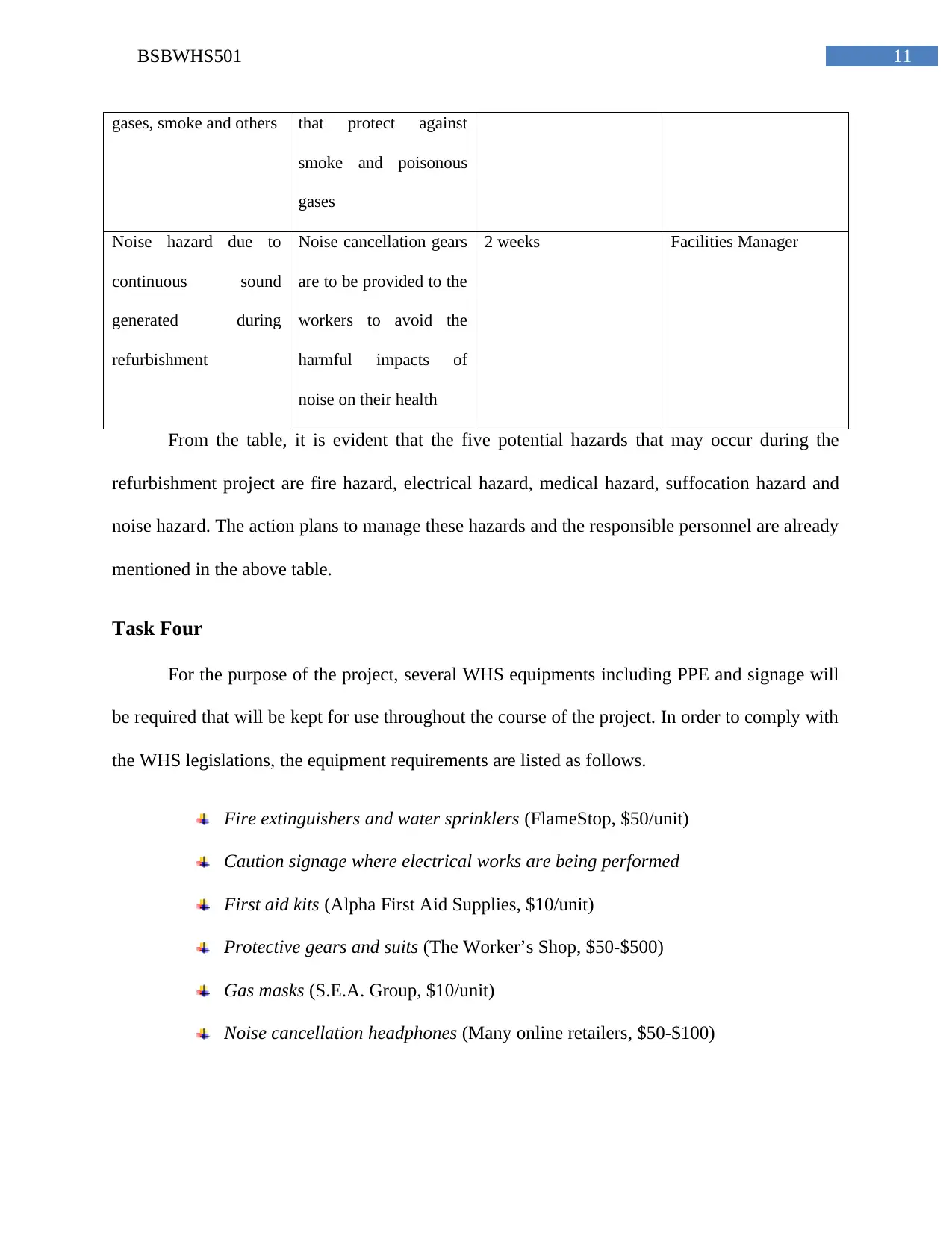
11BSBWHS501
gases, smoke and others that protect against
smoke and poisonous
gases
Noise hazard due to
continuous sound
generated during
refurbishment
Noise cancellation gears
are to be provided to the
workers to avoid the
harmful impacts of
noise on their health
2 weeks Facilities Manager
From the table, it is evident that the five potential hazards that may occur during the
refurbishment project are fire hazard, electrical hazard, medical hazard, suffocation hazard and
noise hazard. The action plans to manage these hazards and the responsible personnel are already
mentioned in the above table.
Task Four
For the purpose of the project, several WHS equipments including PPE and signage will
be required that will be kept for use throughout the course of the project. In order to comply with
the WHS legislations, the equipment requirements are listed as follows.
Fire extinguishers and water sprinklers (FlameStop, $50/unit)
Caution signage where electrical works are being performed
First aid kits (Alpha First Aid Supplies, $10/unit)
Protective gears and suits (The Worker’s Shop, $50-$500)
Gas masks (S.E.A. Group, $10/unit)
Noise cancellation headphones (Many online retailers, $50-$100)
gases, smoke and others that protect against
smoke and poisonous
gases
Noise hazard due to
continuous sound
generated during
refurbishment
Noise cancellation gears
are to be provided to the
workers to avoid the
harmful impacts of
noise on their health
2 weeks Facilities Manager
From the table, it is evident that the five potential hazards that may occur during the
refurbishment project are fire hazard, electrical hazard, medical hazard, suffocation hazard and
noise hazard. The action plans to manage these hazards and the responsible personnel are already
mentioned in the above table.
Task Four
For the purpose of the project, several WHS equipments including PPE and signage will
be required that will be kept for use throughout the course of the project. In order to comply with
the WHS legislations, the equipment requirements are listed as follows.
Fire extinguishers and water sprinklers (FlameStop, $50/unit)
Caution signage where electrical works are being performed
First aid kits (Alpha First Aid Supplies, $10/unit)
Protective gears and suits (The Worker’s Shop, $50-$500)
Gas masks (S.E.A. Group, $10/unit)
Noise cancellation headphones (Many online retailers, $50-$100)
⊘ This is a preview!⊘
Do you want full access?
Subscribe today to unlock all pages.

Trusted by 1+ million students worldwide
1 out of 16
Related Documents
Your All-in-One AI-Powered Toolkit for Academic Success.
+13062052269
info@desklib.com
Available 24*7 on WhatsApp / Email
![[object Object]](/_next/static/media/star-bottom.7253800d.svg)
Unlock your academic potential
Copyright © 2020–2025 A2Z Services. All Rights Reserved. Developed and managed by ZUCOL.



